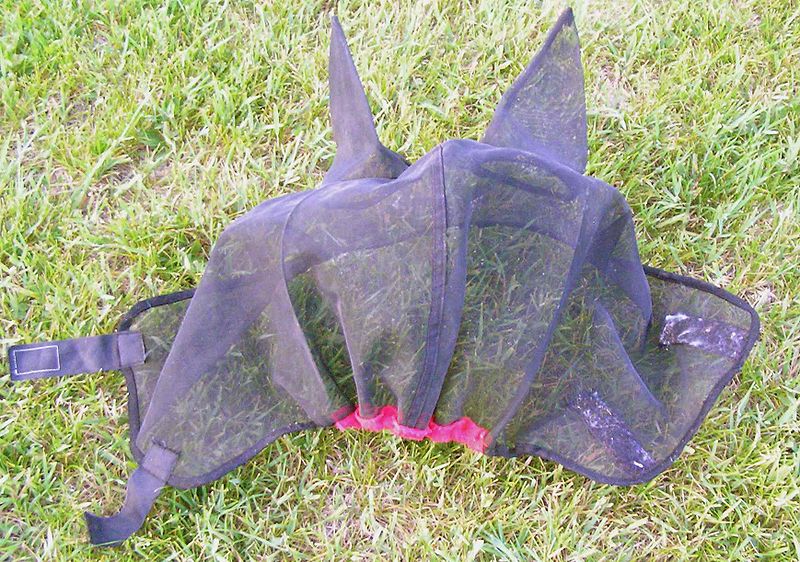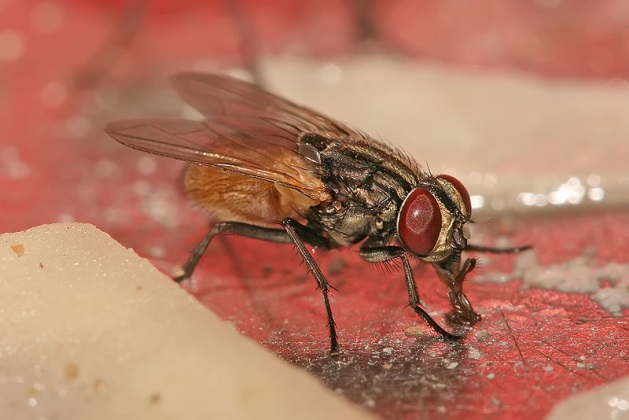 There are many things to look forward to during the spring and summer months. The warm temperatures, longer hours of sunlight, and flourishing plant life. However, with these seasons comes a horrifying predator to both equine and humans; FLIES. Fly control may be something overlooked as well as overdone. It is important to consider several factors when deciding the correct form of fly control for your environment, circumstance, or herd. This article discusses the lines of defense against flies and the types of flies which typically affect horses. By understanding each of these factors, one will be able to better identify which product of fly control protects you and your horses the best.
There are many things to look forward to during the spring and summer months. The warm temperatures, longer hours of sunlight, and flourishing plant life. However, with these seasons comes a horrifying predator to both equine and humans; FLIES. Fly control may be something overlooked as well as overdone. It is important to consider several factors when deciding the correct form of fly control for your environment, circumstance, or herd. This article discusses the lines of defense against flies and the types of flies which typically affect horses. By understanding each of these factors, one will be able to better identify which product of fly control protects you and your horses the best.
Lines of Defense
 There are five lines of defense for fly control. First is to prevent flies from breeding. Sanitation around the barn area is crucial in eliminating breeding sites for fly larvae. Common sites that require attention include the manure pile, standing water, muddy areas, and plant debris. Spreading the manure pile in a timely fashion will promote drying and prevents fly larvae from developing. Drainage control and regular upkeep will help to reduce standing water and muddy areas. Proper removal of plant debris can decrease fly breeding sites and can make chemical control more successful. Use of screens can prevent flies from entering a designated area all together. A constant low air flow will also keep flies from entering an area since they may not be able to land.
There are five lines of defense for fly control. First is to prevent flies from breeding. Sanitation around the barn area is crucial in eliminating breeding sites for fly larvae. Common sites that require attention include the manure pile, standing water, muddy areas, and plant debris. Spreading the manure pile in a timely fashion will promote drying and prevents fly larvae from developing. Drainage control and regular upkeep will help to reduce standing water and muddy areas. Proper removal of plant debris can decrease fly breeding sites and can make chemical control more successful. Use of screens can prevent flies from entering a designated area all together. A constant low air flow will also keep flies from entering an area since they may not be able to land.
The second line of defense is to prevent larvae from hatching. The use of fly predators or insecticides will greatly reduce hatching larvae. A fly predator is a hymenopteran insect which act in a parasitic way by entering the pest fly’s pupa stage cocoon. The female fly predator drills a hole in the cocoon and inserts her own eggs. She then uses the developing pest fly’s fluids as nutrition by ingesting them. The benefit of the fly predator, also referred to as a parasitic wasp, is that they do not sting or bite once fully grown.
 Capturing adult flies is the third line of defense. The practice of using fly traps or fly paper is most common. Fly traps attract adult flies by using either different feeding ingredients irresistible to flies or using sex pheromones to attract the adult fly. Some fly traps use a combination of both to attract the flies. Fly paper is similar but instead of using an enclosed container to collect all of the flies it is a long strip of an extremely sticky, sweet and sometimes poisonous substance. Once the flies land on the paper they will not be able to fly off.
Capturing adult flies is the third line of defense. The practice of using fly traps or fly paper is most common. Fly traps attract adult flies by using either different feeding ingredients irresistible to flies or using sex pheromones to attract the adult fly. Some fly traps use a combination of both to attract the flies. Fly paper is similar but instead of using an enclosed container to collect all of the flies it is a long strip of an extremely sticky, sweet and sometimes poisonous substance. Once the flies land on the paper they will not be able to fly off.
There are numerous methods to the fourth stage of defense which is to kill any remaining flies. This can be done by using bug zappers, residual insecticide spray, foggers, automatic misters, and fly bait/poison. Bug zappers attract all different kinds of insects by using an ultraviolet light to draw the insect in. Once touching the electrified wire grids around the light, the insect is “zapped” with electricity. Residual insecticide spray is any chemical based formula used to kill insects. When selecting which insecticide spray to use, keep in mind the active ingredient and the concentration. Insecticide sprays are usually applied to walls, ceilings, floors, fences, and any other area where an insect may rest. Some sprays are much more potent than others and may require a “rest” period before it is safe for humans or equines to venture in the area. Foggers or automatic misters are safer around humans and equines than other insecticides which may need time to clear. They are usually much more effective in an enclosed area such as a tack room because they are fast acting. Fly bait/poison is a granular substance used to kill flies. They are often put into bait stations, which are shallow trays in highly infested areas. The fly feeds on the bait and rapidly dies after ingestion. Exposure to humans or equines should be reduced when using fly bait/poison.
 Finally, the last line of defense is to protect your horse against any flies that make it through the first four lines of defense. Using fly repellents, fly masks/sheets, and fly strip/tags. There are many variations of fly repellents. A few include but are not limited to; Farnam Bronco, Repel-X, Sentry, Bite Free, Equicare Flysect, Tri-Tec, and Absorbine UltraShield. Keep in mind there are alcohol based and water based solutions for fly repellents. Alcohol based repellents may have a shorter period of time it is effective since alcohol promotes evaporation.
Fly masks (photo right) and fly sheets act as a physical barrier layer from flies. Flies may land on the area of the mask or sheet but usually are not able to penetrate the horse’s skin through the material.
Finally, the last line of defense is to protect your horse against any flies that make it through the first four lines of defense. Using fly repellents, fly masks/sheets, and fly strip/tags. There are many variations of fly repellents. A few include but are not limited to; Farnam Bronco, Repel-X, Sentry, Bite Free, Equicare Flysect, Tri-Tec, and Absorbine UltraShield. Keep in mind there are alcohol based and water based solutions for fly repellents. Alcohol based repellents may have a shorter period of time it is effective since alcohol promotes evaporation.
Fly masks (photo right) and fly sheets act as a physical barrier layer from flies. Flies may land on the area of the mask or sheet but usually are not able to penetrate the horse’s skin through the material.
Impregnated resin strips release vapors over a four month period which affect the fly’s nervous system and eventually kills them. Different strips can be applied to an area, or even to a piece of equipment the horse is around, for example their halter.
7 Species of Flies
There are 7 basic species of flies which can affect horses. These include the bot fly, horse fly, deer fly, face fly, horn fly, house fly, and stable fly.
- Bots are fly larvae found in the horses’ stomach acting more like a parasite. The adult bot fly (photo top right) looks similar to bees and lay their eggs on the horse’s hair, usually on the legs. The eggs are deliberately placed in an area where the horse is likely to lick so the hatched egg may enter the horse’s mouth and continue to the digestive tract. Once in the stomach they use their oral hooklets to attach to the stomach wall.
- Both the horse fly and deer fly are large bloodsucking flies. Their bites can cause welts or bumps. Horse flies are a common vector of EIA and are more commonly found near water.
- The face fly is more of a nuisance than a blood sucking fly. The face fly feeds on secretions, usually around the eyes of the horse. Unfortunately, the negative aspect is the face fly can mechanically transmit pathogens from horse to horse.
- Although more pertinent to cattle, the horn fly (photo top left) can be around horses especially if in the vicinity of grazing cattle. The horn fly is a biting fly and half the size of a stable fly. Horn flies often remain on their host, sometimes undetected.
 House flies (photo bottom right) are also a nuisance fly being that they don’t actually bite but instead eat a variety of plants and animal wastes. Large quantities in an area make them an annoyance. House flies land in various places which can be a means of wound contamination.
House flies (photo bottom right) are also a nuisance fly being that they don’t actually bite but instead eat a variety of plants and animal wastes. Large quantities in an area make them an annoyance. House flies land in various places which can be a means of wound contamination. - Stable flies (photo above middle left) look quite similar to a house fly. However, they can inflict a painful bite. These too are blood sucking flies, but are more unlikely to carrier disease agents. Stable flies are known for biting the legs, belly, and head of the horse.
Sanitation and good management practices are significant to proper fly control. In order to significantly reduce the fly population one should understand the five lines of defense and the types of flies which inhabit the area around their horses.


Log in to join the conversation.